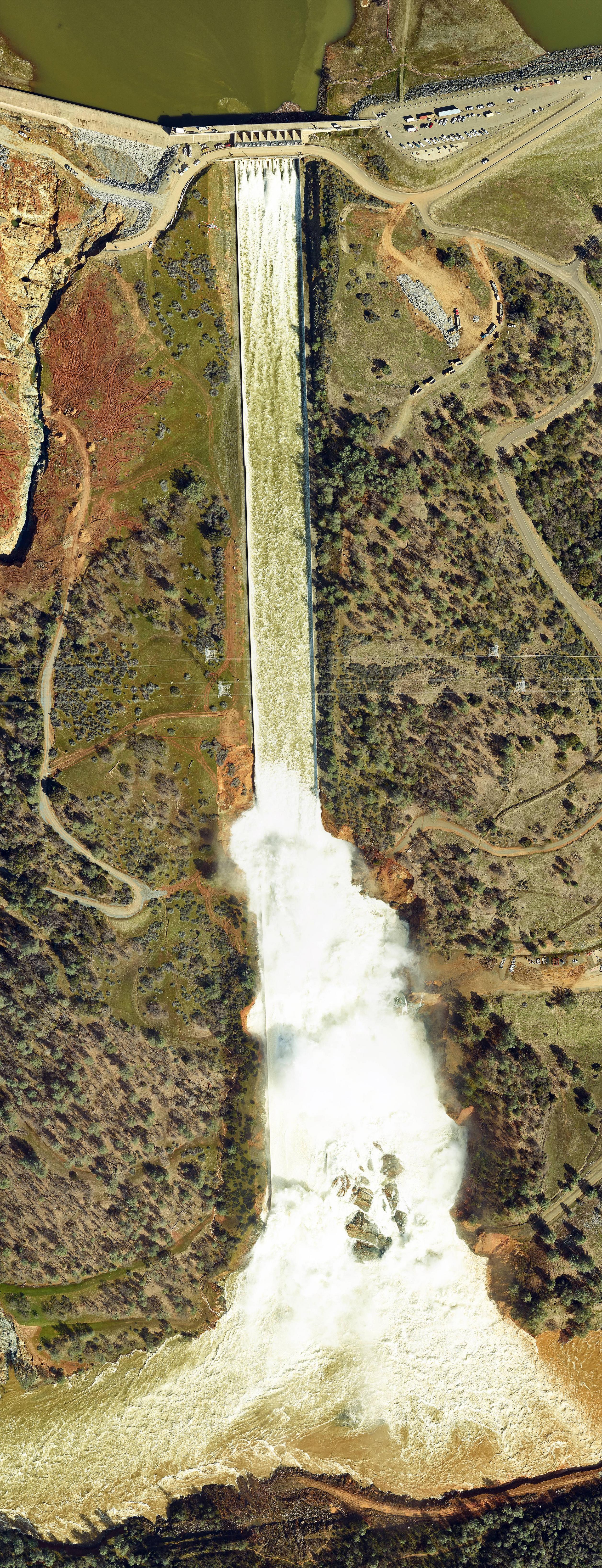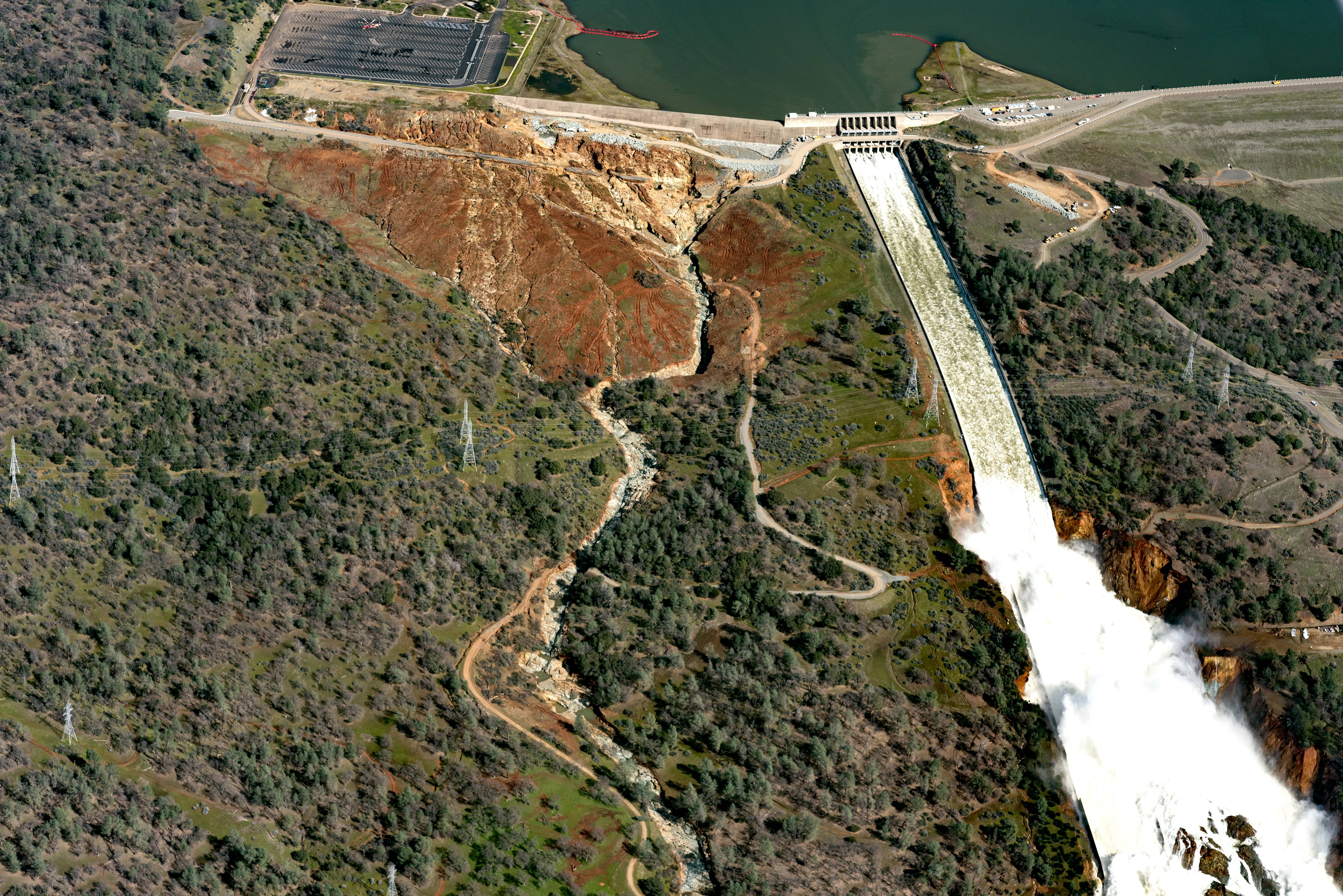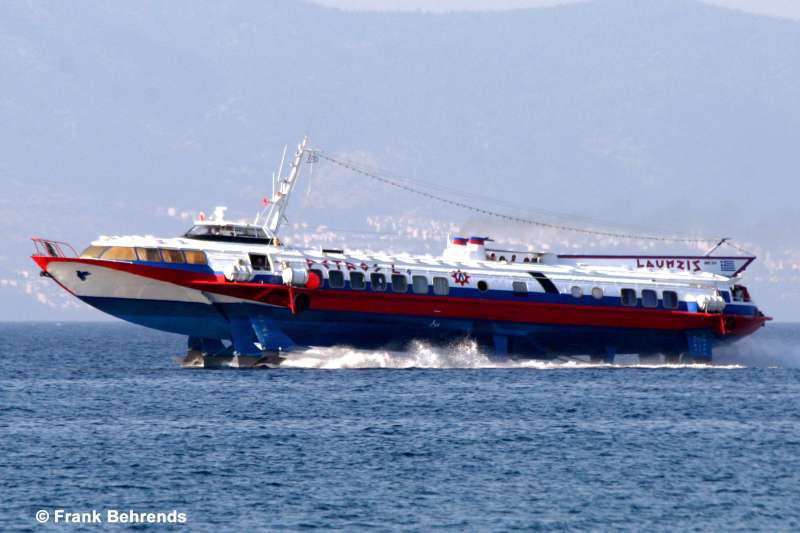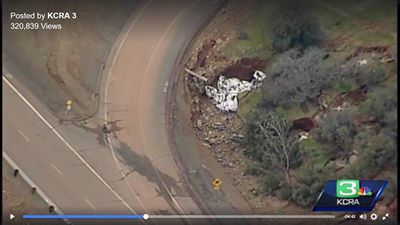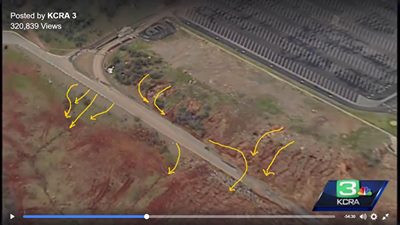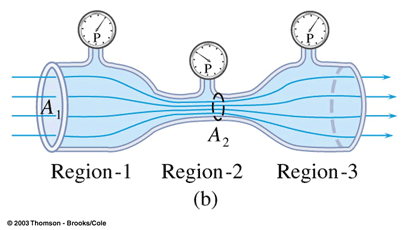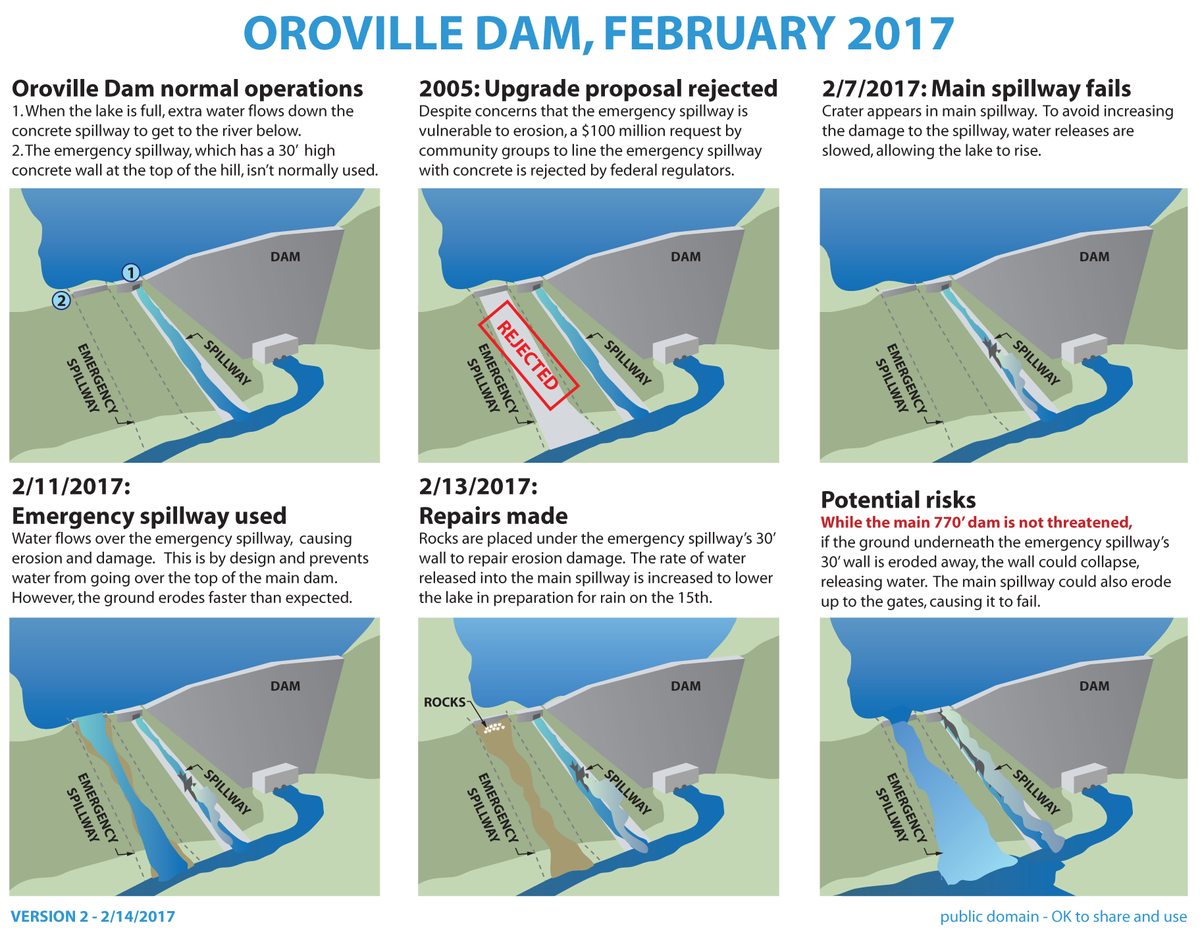Sailing Mark
New Member
Just a few notes on the actual main spillway fracture plus two links on the oldest working dam in the world circa, 1309-1304 BC, showing its value for money. In my locality, a slightly newer dam built 1861.
I have reason to submit that the original fault in the emergency slipway has been caused by incorrectly angled concrete deck that caused suction due to release of compression as the water travelled downhill.
As one can see from the numerous photographs on this discussion, the angle of the slipway changes at about 40% down slope. The down flow of water under steady compression is forced to amplify speed causing the top 25-30% of down flow to increase speed thus causing a decompression or suction against the rest of flow. This suction at an estimated 200 metric tons per Square Meter would be sufficient to start a crack propagation phenomenon usually known as a subcritical crackhttps://www.metabunk.org/#_edn1. As it looks as if the concrete was not anchored via pilings etc at this area, the vertical stress would be sufficient to cause failure. Note that the failure is downhill of the actual angle change as it takes time for the decompression or suction effect to reach peak.
During a shear test, peak stress is located within the large strain zone at a strain value ɛf defining the material failure. Deviatoric peak stress qf, failure strain ɛf and the stiffness at very small strains are parameters needed to calculate both rigidity and degree of small strains.
ETan Very small strains
Esec
Eo
f
qf
q = ( a-r)
Failure ETan and Esec
Eo
0.1%
ETan
Esec
log
Large strains
Figure 1. Schematic stress-strain and stiffness-strain curves
for a natural soil (from Atkinson, 2000).
Non-linearity of soils. These are two parameters are used to determine the stiffness decay curve of soils (Atkinson, 2000). Rigidity is defined as the ratio of stiffness to strength (E/qf=1/εf) while the degree of non-linearity can be defined as the ratio of failure strain to a reference strain εf/εr. Using these concepts, Atkinson (2000) presented a simple non-linear stiffness-strain curve in terms of the tangent Young’s modulus Etan that is mathematically defined as:
Etan
E0=
1−εf
εr
1−εf
ε0r(1)
Where E0 is the Young modulus at very small strain for a strain ε0, εfis the strain at the peak Deviatoric stress
In addition, ris a soil parameter which includes the degree of non-linearity. According to Atkinson (2000), f saturated conditions, rcan vary from 0.1 to 0.5.[ii] I have used soil as it is the basic knowledge but the principle is the same for any particle however bonded.
The presence of water in building materials can lead to cracks which result from freeze/thaw cycles or, in combination with very low permeability's, to the spalling of high performance concrete exposed to fires. In addition, the invasion of water in building materials provides a mechanism and path for the penetration of deleterious materials like chloride and sulphate ions. While the primary transport mechanisms by which chloride and sulphate ions ingress concrete are diffusion and capillary action, diffusion alone can be a very slow process, hence it may be that capillary transport, especially near an unsaturated concrete surface, is the dominant invasion mechanism. Clearly, an understanding of moisture transport in concrete and mortar is important to estimate their service life as a building material and to improve their quality[iii]. As such, as this is an earthquake area, has the emergency slipway suffered cracks that were actually deeper than known.
Several posts have noted that there may have been cavitations[iv] that may have or presumably did cause shock waves, which would have occurred under the down flow angle, change as noted.
To fix the problem in the future;
https://www.metabunk.org/#_ednref1 http://www.icevirtuallibrary.com/doi/abs/10.1680/geot.2003.53.2.289?journalCode=jgeot
[ii] https://www.researchgate.net/publication/277677537_Suction_effects_on_the_pre
failure_behaviour_of_a_compacted_clayey_soil
[iii] http://ciks.cbt.nist.gov/~garbocz/captrans/node1.html
[iv] https://en.wikipedia.org/wiki/Cavitation
I have reason to submit that the original fault in the emergency slipway has been caused by incorrectly angled concrete deck that caused suction due to release of compression as the water travelled downhill.
As one can see from the numerous photographs on this discussion, the angle of the slipway changes at about 40% down slope. The down flow of water under steady compression is forced to amplify speed causing the top 25-30% of down flow to increase speed thus causing a decompression or suction against the rest of flow. This suction at an estimated 200 metric tons per Square Meter would be sufficient to start a crack propagation phenomenon usually known as a subcritical crackhttps://www.metabunk.org/#_edn1. As it looks as if the concrete was not anchored via pilings etc at this area, the vertical stress would be sufficient to cause failure. Note that the failure is downhill of the actual angle change as it takes time for the decompression or suction effect to reach peak.
During a shear test, peak stress is located within the large strain zone at a strain value ɛf defining the material failure. Deviatoric peak stress qf, failure strain ɛf and the stiffness at very small strains are parameters needed to calculate both rigidity and degree of small strains.
ETan Very small strains
Esec
Eo
f
qf
q = ( a-r)
Failure ETan and Esec
Eo
0.1%
ETan
Esec
log
Large strains
Figure 1. Schematic stress-strain and stiffness-strain curves
for a natural soil (from Atkinson, 2000).
Non-linearity of soils. These are two parameters are used to determine the stiffness decay curve of soils (Atkinson, 2000). Rigidity is defined as the ratio of stiffness to strength (E/qf=1/εf) while the degree of non-linearity can be defined as the ratio of failure strain to a reference strain εf/εr. Using these concepts, Atkinson (2000) presented a simple non-linear stiffness-strain curve in terms of the tangent Young’s modulus Etan that is mathematically defined as:
Etan
E0=
1−εf
εr
1−εf
ε0r(1)
Where E0 is the Young modulus at very small strain for a strain ε0, εfis the strain at the peak Deviatoric stress
In addition, ris a soil parameter which includes the degree of non-linearity. According to Atkinson (2000), f saturated conditions, rcan vary from 0.1 to 0.5.[ii] I have used soil as it is the basic knowledge but the principle is the same for any particle however bonded.
The presence of water in building materials can lead to cracks which result from freeze/thaw cycles or, in combination with very low permeability's, to the spalling of high performance concrete exposed to fires. In addition, the invasion of water in building materials provides a mechanism and path for the penetration of deleterious materials like chloride and sulphate ions. While the primary transport mechanisms by which chloride and sulphate ions ingress concrete are diffusion and capillary action, diffusion alone can be a very slow process, hence it may be that capillary transport, especially near an unsaturated concrete surface, is the dominant invasion mechanism. Clearly, an understanding of moisture transport in concrete and mortar is important to estimate their service life as a building material and to improve their quality[iii]. As such, as this is an earthquake area, has the emergency slipway suffered cracks that were actually deeper than known.
Several posts have noted that there may have been cavitations[iv] that may have or presumably did cause shock waves, which would have occurred under the down flow angle, change as noted.
To fix the problem in the future;
- Change angle of Emergency spillway to remove decompression zone.
- Place pilings at 5% above, below, and on decompression zone to anchor slipway deck.
I await your musings.
As promised links to that aged technology.
http://www.water-technology.net/features/feature-the-worlds-oldest-dams-still-in-use/
http://www.southwestwater.co.uk/index.cfm?articleid=1529
https://www.metabunk.org/#_ednref1 http://www.icevirtuallibrary.com/doi/abs/10.1680/geot.2003.53.2.289?journalCode=jgeot
[ii] https://www.researchgate.net/publication/277677537_Suction_effects_on_the_pre
failure_behaviour_of_a_compacted_clayey_soil
[iii] http://ciks.cbt.nist.gov/~garbocz/captrans/node1.html
[iv] https://en.wikipedia.org/wiki/Cavitation

